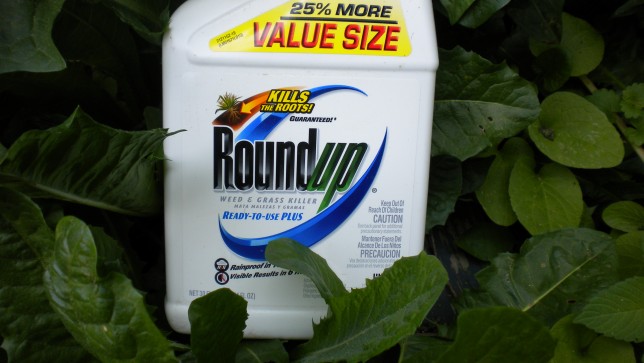US government researchers have uncovered evidence that some popular weedkilling products, like Monsanto’s widely-used Roundup, are potentially more toxic to human cells than their active ingredient is by itself.

Source: www.theguardian.com By Carey Gillam
These “formulated” weedkillers are commonly used in agriculture, leaving residues in food and water, as well as public spaces such as golf courses, parks and children’s playgrounds.
The tests are part of the US National Toxicology Program’s (NTP) first-ever examination of herbicide formulations made with the active ingredient glyphosate, but that also include other chemicals. While regulators have previously required extensive testing of glyphosate in isolation, government scientists have not fully examined the toxicity of the more complex products sold to consumers, farmers and others.
THE GLYPHOSATE BOX
Glyphosate in Hair Testing – Find Out Your Long-Term Exposure to Glyphosate
New: Test Your Water for Glyphosate
Monsanto introduced its glyphosate-based Roundup brand in 1974. But it is only now, after more than 40 years of widespread use, that the government is investigating the toxicity of “glyphosate-based herbicides” on human cells.
The NTP tests were requested by the Environmental Protection Agency (EPA) after the International Agency for Research on Cancer (IARC) in 2015 classified glyphosate as a probable human carcinogen. The IARC also highlighted concerns about formulations which combine glyphosate with other ingredients to enhance weed killing effectiveness. Monsanto and rivals sell hundreds of these products around the world in a market valued at roughly $9bn.
Mike DeVito, acting chief of the National Toxicology Program Laboratory, told the Guardian the agency’s work is ongoing but its early findings are clear on one key point. “We see the formulations are much more toxic. The formulations were killing the cells. The glyphosate really didn’t do it,” DeVito said.
The NTP tests were requested by the Environmental Protection Agency (EPA) after the International Agency for Research on Cancer (IARC) in 2015 classified glyphosate as a probable human carcinogen. The IARC also highlighted concerns about formulations which combine glyphosate with other ingredients to enhance weed killing effectiveness. Monsanto and rivals sell hundreds of these products around the world in a market valued at roughly $9bn.
Mike DeVito, acting chief of the National Toxicology Program Laboratory, told the Guardian the agency’s work is ongoing but its early findings are clear on one key point. “We see the formulations are much more toxic. The formulations were killing the cells. The glyphosate really didn’t do it,” DeVito said.
A summary of the NTP work stated that glyphosate formulations decreased human cell “viability”, disrupting cell membranes. Cell viability was “significantly altered” by the formulations, it stated.
DeVito said the NTP first-phase results do not mean the formulations are causing cancer or any other disease. While the work does show enhanced toxicity from the formulations, and show they kill human cells, the NTP appears to contradict an IARC finding that glyphosate and/or its formulations induce oxidative stress, one potential pathway toward cancer. The government still must do other testing, including examining any toxic impact on a cell’s genetic material, to help add to the understanding of risks, according to DeVito.
The NTP work informs a global debate over whether or not these glyphosate-based weedkilling chemical combinations are endangering people who are exposed. More than 4,000 people are currently suing Monsanto alleging they developed cancer from using Roundup, and several European countries aremoving to limit the use of these herbicides.
“This testing is important, because the EPA has only been looking at the active ingredient. But it’s the formulations that people are exposed to on their lawns and gardens, where they play and in their food,” said Jennifer Sass, a scientist with the Natural Resources Defense Council.
One problem government scientists have run into is corporate secrecy about the ingredients mixed with glyphosate in their products. Documents obtained through Freedom of Information Act requests show uncertainty within the EPA over Roundup formulations and how those formulations have changed over the last three decades.
That confusion has continued with the NTP testing.
“We don’t know what the formulation is. That is confidential business information,” DeVito said. NTP scientists sourced some samples from store shelves, picking up products the EPA told them were the top sellers, he said.
It is not clear how much Monsanto itself knows about the toxicity of the full formulations it sells. But internal company emails dating back 16 years, which emerged in a court case last year, offer a glimpse into the company’s view. In one 2003 internal company email, a Monsanto scientist stated: “You cannot say that Roundup is not a carcinogen … we have not done the necessary testing on the formulation to make that statement. The testing on the formulations are not anywhere near the level of the active ingredient.” Another internal email, written in 2010, said: “With regards to the carcinogenicity of our formulations we don’t have such testing on them directly.” And an internal Monsanto email from 2002 stated: “Glyphosate is OK but the formulated product … does the damage.”


















Re-discovering the powder !
My group has already done that, and published that and a lot more since 2005, that is why the WHO has cited us to classify Roundup as a possible carcinogen.
Pr. Gilles-Eric Séralini
University of Caen.